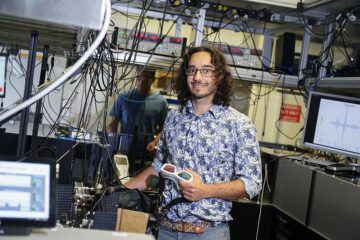ATTO-TEC® GenePin®

High-sensitivity detection methods are increasingly important in many fields, such as early-stage diagnostic of a viral or bacterial infection, environmental studies, health care, and basic physical and biochemical research. For DNA detection most methods use the polymerase chain reaction (PCR) to increase the concentration of target sequence prior to analysis. In order to determine the presence of a specific DNA sequence it is necessary to hybridize fluorescently labeled oligonucleotide probes and immobilize the hybrids on a solid surface. After removal of the unhybridized probes by a washing step the remaining fluorescence intensity is measured. The requirement that unhybridized probe molecules have to be removed precludes the use of this technique for on-line monitoring of hybridization. In addition, the physical separation of unhybridized probe molecules in a heterogeneous assay decreases the sensitivity due to nonspecific binding of probe molecules on the surface. Therefore, homogeneous assays using fluorescently labeled oligonucleotides are a desirable alternative.

ATTO-TEC® GenePin® is a DNA reporter system suited for homogeneous gene assays. It consists of individually designed oligonucleotides labeled with a dye sensitive to its molecular environment, i.e. the DNA sequence in close neighborhood. ATTO-TEC® GenePin® lights up when binding to its target sequence: as soon as the target counter strand is present, the GenePin® exhibits a strong increase in fluorescence intensity. ATTO-TEC® GenePin® is based on a molecular recognition process and balanced hybridization properties. In the absence of the target sequence GenePin® forms a stable hairpin structure which exhibits only minimal fluorescence intensity. When the target sequence is present the hairpin hybridizes spontaneously to the target thereby increasing its fluorescence intensity drastically.
Since hairpins recognize their neighboring DNA bases in close vicinity they have been called "Smart Probes"*. In contrast to double-labeled hairpin structures the synthesis of GenePins® is drastically simplified. In addition, incompletely labeled probes do not contribute to the measured signal as in case of double-labeled hairpin probes. Especially in applications that require higher identification sensitivities, photodestruction of the acceptor chromophore and subsequent increase of donor fluorescence intensity might render the unequivocal identification of hybridization events to target DNA more difficult. In contrast, unlabeled or photobleached fluorophores do not contribute to the measured signal in case of the ATTO-TEC® GenePin® concept.
In order to further increase the identification sensitivity ATTO-TEC® developed a multidimensional analysis strategy at the single molecule level. The strategy takes advantage of the fact that individual GenePins® exhibit several different characteristic after hybridization to the target sequence. Besides higher burst sizes and longer burst durations probe-target duplexes exhibit a significantly increased fluorescence decay time. This enables the efficient discrimination between closed and hybridized probe-target duplexes down to target concentrations of 10-12 M, i.e. identification of probe-target duplexes in the presence of a 200-fold excess of smart probe molecules.
* J. P. Knemeyer, N. Marmé & M. Sauer, Probes for detection of specific DNA sequences at the single-molecule level, Anal. Chem. 72 (2000) 3717.
Media Contact
Alle Nachrichten aus der Kategorie: Biowissenschaften Chemie
Der innovations-report bietet im Bereich der "Life Sciences" Berichte und Artikel über Anwendungen und wissenschaftliche Erkenntnisse der modernen Biologie, der Chemie und der Humanmedizin.
Unter anderem finden Sie Wissenswertes aus den Teilbereichen: Bakteriologie, Biochemie, Bionik, Bioinformatik, Biophysik, Biotechnologie, Genetik, Geobotanik, Humanbiologie, Meeresbiologie, Mikrobiologie, Molekularbiologie, Zellbiologie, Zoologie, Bioanorganische Chemie, Mikrochemie und Umweltchemie.
Neueste Beiträge

Neue universelle lichtbasierte Technik zur Kontrolle der Talpolarisation
Ein internationales Forscherteam berichtet in Nature über eine neue Methode, mit der zum ersten Mal die Talpolarisation in zentrosymmetrischen Bulk-Materialien auf eine nicht materialspezifische Weise erreicht wird. Diese „universelle Technik“…

Tumorzellen hebeln das Immunsystem früh aus
Neu entdeckter Mechanismus könnte Krebs-Immuntherapien deutlich verbessern. Tumore verhindern aktiv, dass sich Immunantworten durch sogenannte zytotoxische T-Zellen bilden, die den Krebs bekämpfen könnten. Wie das genau geschieht, beschreiben jetzt erstmals…

Immunzellen in den Startlöchern: „Allzeit bereit“ ist harte Arbeit
Wenn Krankheitserreger in den Körper eindringen, muss das Immunsystem sofort reagieren und eine Infektion verhindern oder eindämmen. Doch wie halten sich unsere Abwehrzellen bereit, wenn kein Angreifer in Sicht ist?…





















